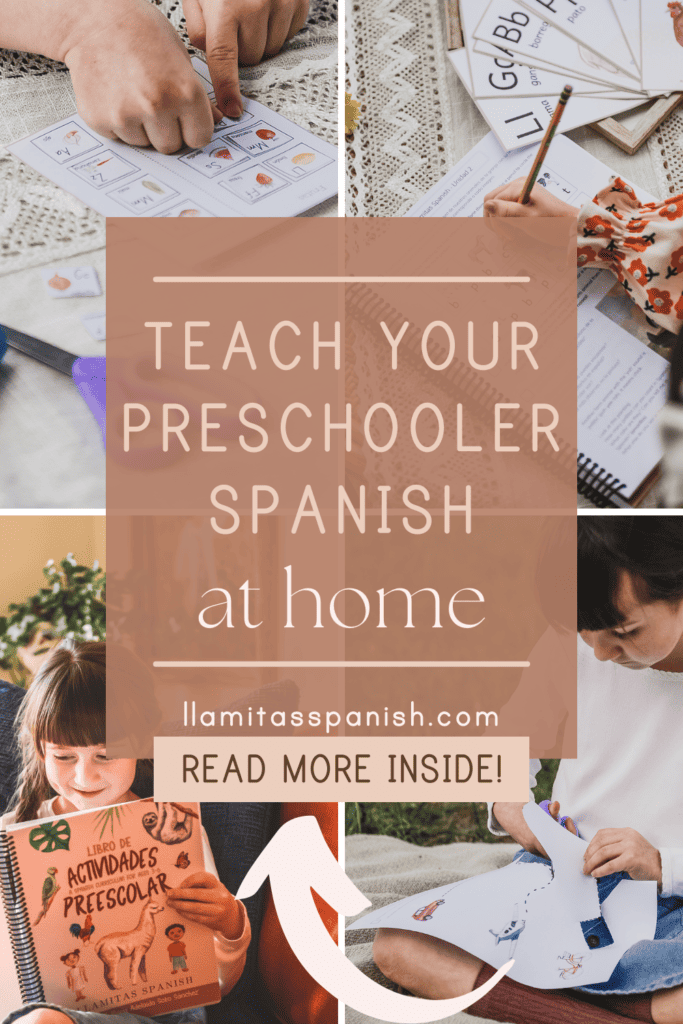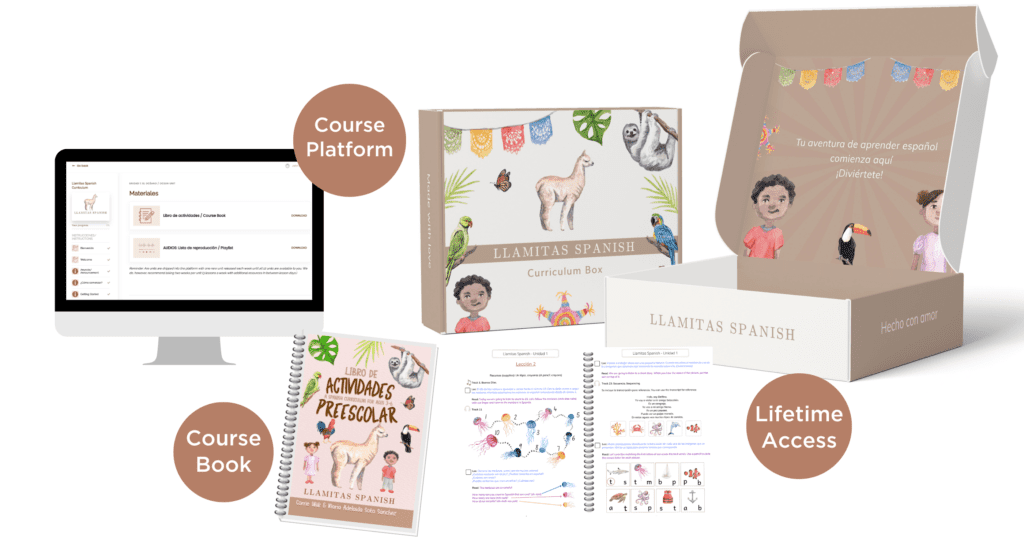In this post: Find everything you need for your preschool and kindergarten Spanish lessons right here!
When it comes to language learning, you really can’t start too soon! Teaching Spanish to your preschooler or kindergartener is a great idea and will give them a head-start toward enjoying the benefits of bilingualism.

This post contains affiliate links. As an Amazon associate I earn from qualifying purchases.
Over and over again, studies have shown that learning a language when you’re young often has the best outcome. That’s because, as you’ve probably heard, young children’s minds are like sponges—they’re primed and ready for input.
More recently, a 2018 study conducted at MIT concluded that learning a new language before the age of 10 is ideal for fluency. So, why not start now?
Don’t worry if you don’t speak Spanish yourself—you can still teach your preschooler Spanish at home! We have all of the resources you need, whether you’re looking for simple games and songs to get started or a full year preschool and kindergarten Spanish curriculum.
Table of Contents
Preschool Spanish Fundamentals
Preschool is all about play-based learning, and your preschool Spanish lessons will be no different. And just like any other preschool curricula, a preschool Spanish curriculum should be focused on teaching your child early learning concepts through play.
These early concepts include:
- Alphabet
- Numbers and counting
- Colors
- Shapes
- Days of the week
- Months of the year
- Weather
- Greetings
- Animals and animal sounds
- Same and different
- Patterns
If you’re already working on these preschool concepts in English with your child, that’s great! You will use this same approach to give your child the foundations of learning Spanish.
In addition to those first concepts, preschool is the time to begin working on social-emotional skills, like understanding feelings and expressing wants and needs.
You’ll want them to learn the vocabulary and phrases in Spanish needed to support these skills. For example, learning phrases like “I’m hungry” (“Tengo hambre”) or the word for bathroom (baño) are important at the preschool level in any language!
To get you started, here are a few of our posts that may be helpful in planning your preschool Spanish lessons:
- El Abecedario: The Spanish Alphabet for Kids
- Counting in Spanish Made Easy
- Colors in Spanish: Fun Activities for Kids
- Exploring Shapes in Spanish
- Days of the week songs in Spanish

How to Teach Spanish to Preschoolers
If you’re just adding a foreign language to your homeschooling, or are new to homeschooling altogether, you may be wondering what this might look like.
With the right materials, teaching Spanish at the preschool level can actually be easy, even if you don’t speak the language yourself! You can even learn alongside your child. (The Llamitas Spanish curriculum makes it easy!)
There are a few things to keep in mind when planning Spanish lessons for preschool and kindergarten.
Have Fun
We can’t emphasize enough that teaching Spanish in preschool should be fun! Young children learn through play. Joy should be at the heart of their language learning experience in the early years.
Movement and music are essential for keeping preschool age children engaged. They’ll need to get those wiggles out, even during their Spanish lesson.
You can do this by dancing to Spanish songs on YouTube or learning some Spanish finger plays together.
Another fun option is to get out any musical instruments you might have (or make your own with empty containers and kitchen utensils) and play along to some timeless nursery rhymes together.
Focus on Input
When it comes to language learning at any age, input (reading and listening) is so important. This means that you want your child to have plenty of exposure to authentic Spanish throughout the day.
You can accomplish this with the use of materials like:
- Music
- Audiobooks and podcasts
- Spanish TV shows, movies, or videos
- Stories and books
- Flashcards
- Games
- Manipulatives
If you aren’t fluent in Spanish, you’ll want to use resources with native speakers like audiobooks, recordings, and apps when you can. But you can also practice your own pronunciation by reading to your child in Spanish.
When you’re just getting started reading in Spanish, pick out simple Spanish books for beginners. Board books and first word books are great options for reading to preschoolers.

Remember the Four Language Skills
As a language teacher, I always incorporated the four language skills in each lesson: reading, writing, listening, and speaking. All of these are essential for language learning at any age and any level!
In preschool and kindergarten, of course, this may look a little different than it does for older children or adults. For example, reading and writing may be covered by working on letter recognition, sight words in, and tracing letters from the Spanish alphabet.
Thematic lessons, like those in the Llamitas curriculum, are a great way to easily incorporate all four language skills into your lessons.

Repeat!
Don’t be afraid to use the same materials and activities often with your preschooler as long as it’s still keeping their interest. Repetition is also crucial when you’re teaching Spanish to your little one.
Luckily, preschoolers often love repeating nursery rhymes and singing the same songs over and over again, so this shouldn’t be too hard!
When planning your lessons, having a routine can be extremely helpful, too. Using a certain song, rhyme, or fingerplay can help your child to know that their lesson is beginning or they’re transitioning to a new activity.
Keep Lessons Short
While we encourage you to give your child plenty of exposure to Spanish throughout their day, preschoolers and kindergarteners do best with short lessons. The 3 to 6-year-old age group doesn’t have a very long attention span after all.
A normal preschool day is only about 2 or 3 hours long and usually includes plenty of time for play and exploration. A preschool Spanish lesson should be about 30 to 45 minutes and incorporate plenty of interactive activities during that time.
A sample schedule for a preschool Spanish class might looks like this:
- Warm up and greetings: Practice any phrases you’ve been working on and sing a Spanish greeting song together. This is a good time to review what you’ve learned so far.
- Thematic lesson: This might include any curriculum materials or books you’ve been working through with your child. Keep things interesting with crafts, flashcards, and games if they’re not already included with your workbook.
- Music & movement: Use a fun activity to support the lesson. It could be a game, a dance, or pretend play. Anything that gets your little one up and moving!
- Story time: Read or listen to a Spanish picture book together. Talk about what you see in the pictures and what’s happening in the story.
- Wrap-up: This is a great time to incorporate a routine, such as a Spanish finger play or song, to signal that you’re done for the day.
Free Preschool Spanish Lessons

Whether you’re just getting started teaching Spanish to your child or are on a tight budget, we recommend taking a look at our Free Resource Library. This is a great option if you aren’t quite sure if you’re ready for a full Spanish curriculum and want some lighter materials to get started.
In the freebie library you’ll find:
- Lessons: These are short thematic lessons with printable activities and beautifully illustrated flashcards.
- Games: Play popular Spanish vocabulary games like Lotería! Audio is included for even more language input.
- Resource Guides: Get free tips and even more resources for learning and Spanish.
- Music: You’ll have access to some awesome seasonal Spanish music playlists for kids!
This is the perfect way to introduce your preschooler or kindergartener to Spanish—and yes, it’s totally free! We encourage you to take advantage of these resources to include in your preschool Spanish curriculum.
Related post: The Best Free Spanish Learning Resources for Kids
Llamitas Spanish Preschool and Kindergarten Curricula

We understand that not everyone has time to plan their own lessons from start to finish. If you’re looking for an easy to use, done-for-you Spanish program for your preschooler or kindergartener, you’ll want to take a look at the Llamitas Spanish shop.
Perfect for parents looking for some structure and support along the way, the Llamitas Spanish shop has everything you’ll need to teach your little one Spanish. From morning binders to seasonal units to a full-year curriculum, there are options for every family and budget!
Here’s what you’ll find:
Llamitas Spanish Curriculum

This is the full-year curriculum, an open & go program that does the hard work for you! It’s a 12-unit thematic program that’s rooted in Hispanic culture. This program can be used whether you’re a bilingual family or have no prior Spanish skills.
The Llamitas Spanish curriculum will take care of the planning for you. Each thematic lesson will cover all four language skills with a focus on phonics, math, literacy, music, and art!
Both print and digital versions of this program are available.
Spanish Morning Binder

The Spanish Morning Binder is an affordable option for parents looking for a way to gently introduce Spanish to their preschooler or kindergartener.
With just 15 minutes a day, your child can gain a solid foundation in the Spanish alphabet, colors, numbers, shapes, and more!
This is a digital download that you can print at home. You’ll have flashcards, tracing activities, and even a native speaker audio playlist to support your Spanish lessons.
Learn Spanish en Casa

If you’re in need of some additional guidance, Learn Spanish en Casa is an ebook and workbook duo that will help you along the way.
It will provide you with step-by-step instructions on how to create a language plan so you can teach your kids Spanish at home with confidence.
Seasonal Units

Seasonal units can be a fun addition to your Spanish curriculum and include printable activities, flashcards, cultural magazines, music playlists, and more! These are digital downloads that you can print at home.
The Seasonal Bundle includes seven seasonal units: Valentines Day, Easter, Hispanic Heritage Month (Frida Kahlo Study), Halloween, Day of the Dead, Thanksgiving, and Christmas.
With plenty of Preschool and Kindergarten Spanish lessons to enjoy, we are excited to support you in nurturing a love for the Spanish language at home!
